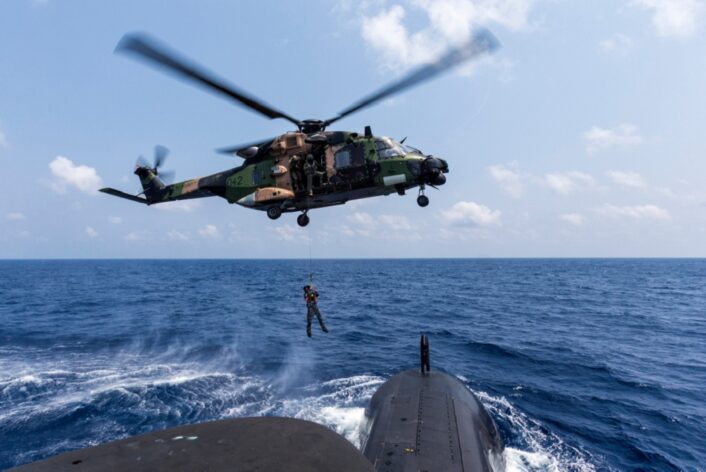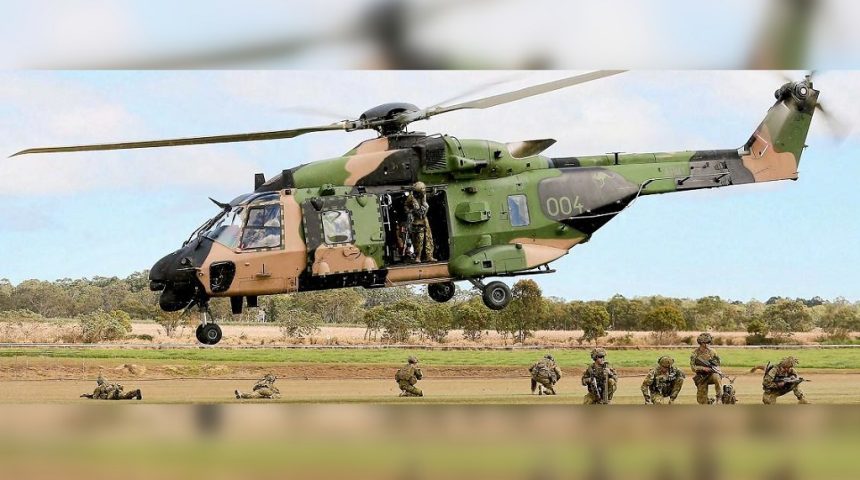The surprising move is due to the numerous problems and low availability during the troubled career of the helicopter.
In a surprising move, the Australian Defence Force has announced that it will retire its entire fleet of MRH90 Taipan helicopters a decade earlier than scheduled. The helos will be replaced by UH-60M Black Hawks and MH-60R Seahawks. This situation is somewhat curious, as the Taipan was supposed to replace the S-70A-9 Black Hawks that the country acquired in the 1980s and it will now be replaced itself by other, newly built Black Hawks.
The MRH90 Taipan is currently used by the Australian Army as its utility helicopter, including support to Special Operations, and provides a maritime support capability for the Royal Australian Navy. The MRH90 is used in various roles, including combat support, humanitarian aid and disaster relief domestically and in the Indo-Pacific region, however the helicopter fleet has not met contracted availability requirements nor the expected cost of ownership ahead of its planned withdrawal from service in 2037.
“Taipan has been a project of concern for the last decade, it’s had nine instances where it’s been unsuitable to fly,” Defence Minister Peter Dutton said on Dec. 10, 2021. “I’m just not going to put our people in that position, we want the best equipment for them, and the Black Hawk clearly is going to provide that outcome. Getting up to 40 of them will, I think, send a very clear message to our partners and to our adversaries that the Australian Defence Force is serious about defending Australia and making sure that we can make a significant contribution when we’re called on.”
The Defence Department had estimated the total cost of the MRH90 program would top $15 billion by its original retirement date planned for 2037, but it has been an ongoing and well-documented concern for Defence, according to the Minister. Because of the MRH 90’s poor availability rates, earlier this year it was revealed that more than $37 million were spent to lease two Leonardo AW139s to augment the Taipan fleet in the Army A and B Squadrons of the 5th Aviation Regiment at RAAF Base Townsville to maintain training and currency throughput.
When asked about the replacement decision during a press conference, Prime Minister Scott Morrison said: “The Taipans weren’t meeting their marks. Simple as that. And we want to make sure that our defence forces have the best possible equipment to defend this country, and the Black Hawks will provide that. That’s a decision that we’ve taken together as a National Security Committee to ensure that we’re keeping Australians safe. I mean, Australia has been lifting our effort when it comes to defending our nation and ensuring that our expenditure on defence is now over two per cent and our commitments, particularly under the AUKUS agreement and moving towards the nuclear fulfilled submarines, I think demonstrates our commitment. But not just that, but it also demonstrates the relationships and partnerships that we’ve been able to build and particularly with the United States. But of course, we will continue to work with many other defence contractor suppliers, but in this case, sadly the Taipans didn’t do what we needed them to do, so we’ll get the things that we need to do it.”
The Army and the Navy currently have 41 and six Taipans in service, respectively, and, despite speed, range, and troop capacity performance advantages over the Black Hawk, have been plagued with poor availability and fleet-wide groundings due to a lack of spares and configuration management issues. Last year Defence also admitted the door on its multi-role Taipans was too narrow to allow its guns to fire while troops are descending from the aircraft.

According to Defense News, Dutton said Australian taxpayers will save about $2.5 billion through 2037 thanks to this move. “The Black Hawk is so much cheaper on a per-hour basis to run than the existing Taipan. The Taipan is unreliable, there’s a lot of money that’s spent on maintenance and a lot of downtime of our pilots and air crews who should be up training and they should be flying these helicopters, and at the moment, in many cases, they just can’t. It’s why we need this capability sooner than later, and I’m hoping over the next couple of years we will have the new Black Hawk in service and that will be a great outcome for the ADF.”
The Army’s 6th Aviation Regiment based at Holsworthy in Sydney received its first MRH90s in 2019 which were to replace its Black Hawks from mid-2020. The Taipan however has reportedly also proven to be unsuitable for the special forces support role in which 6Avn specialises, and the older Black Hawks had to be kept in service, delaying their retirement until at least the end of 2021.
The MRH90 Taipan, named after a deadly venomous snake, is an Australian-specific derivative of the NH90 TTH, developed in Europe by the multinational NHIndustries company, which comprises Airbus Helicopters, Leonardo, and GKN Fokker. NH90s have been ordered in multiple land-based and maritime versions by 14 different countries with more than 446 helicopters delivered. The Army acquired 41 MRH 90s under Project AIR 9000 Phases 2 and 4 and entered service in 2008, while six were acquired for the Navy under AIR 9000 Phase 6 and entered service in 2010. In October the United States approved a $1.3 billion deal for an additional batch of 12 MH-60R Romeo Seahawks for the Navy to replace its MRH 90s and to augment the 23 Romeos already in service.
Defence sources say Airbus was already informed of the government’s decision. “I’ve spoken to the CEO of the company involved about my concerns, a number of months ago, and Defence has been working constantly with the company to try and resolve the issues,” Minister Dutton said. “But clearly [those issues] are unresolvable, and for that reason we’ve made the decision to terminate that program and to go with a Black Hawk program.”
The earlier retirement of the MRH90 Taipan and its replacement with the Black Hawk comes just three months after the government cancelled the $90 billion French Attack-class nuclear submarine program and decided to instead acquire the submarines under the AUKUS agreement with the UK and US. The trilateral AUKUS agreement between the US, UK and Australia greatly angered France. PM Morrison addressed the decision to buy the Black Hawks in light of the same AUKUS agreement.
However, the Taipan is the second European helicopter being scrapped by the Australian Defence Forces, after the AH-64E Apache Guardian was selected as the new armed reconnaissance helicopter earlier this year to replace the Tiger ARH fleet under the Land 4503 program. The deal, estimated to be worth 4-5 USD billion, will procure 29 helicopters, with 24 to be based at a single location with two operational squadrons and the other five for training at the Australian Army Aviation Training Centre.
The Tiger was introduced in service in 2004 but, much like the Taipan, it suffered poor availability rates and high ownership costs early in its career. The decision to acquire the Apache was made under the Australian government’s “Smart Buyer” policy, according to reports, which allows for sole-source selection without a competition if there is a clear preference for a particular platform. It is possible that the same policy was applied to the replacement of the MRH90 with the UH-60M and MH-60R.









